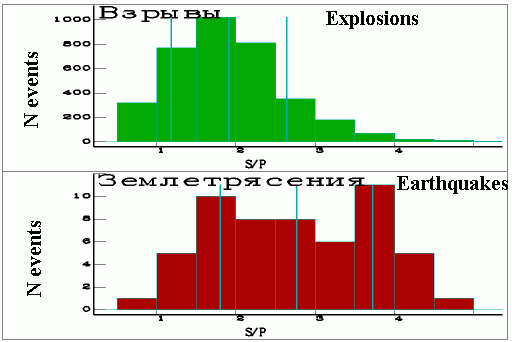Usage of P/S ratio for distinguishing earthquakes and explosions
P and S amplitudes ratio is a well known discriminant of earthquakes and explosions. It is supposed that explosions do not generate significant S waves due to symmetry of the sources, i.e. S/P amplitudes ratio for explosions should be small. On the contrary earthquakes which are movements along some faults and therefore these non-symmetrical sources can generate strong S waves.
We study this parameter for earthquakes and explosions of our region.
See also: Asming V.E., Kremenetskaya E.O. Study of applicability of P/S ratio criterion for discrimination of regional earthquakes and explosions in North-Western area, Observed Characteristics of Regional Seismic Phases and Implications for P/S Discrimination in the European Arctic. Frode Ringdal, Elena Kremenetskaya and Vladimir Asming. Pure appl. geophys. 159 (2002).
On the first stage we developed a stable way to P/S calculations. For this purpose we made a PSCalc program which enables to process single channels and 3-component recordings. For processing the recordings are passed through sets of bandpass filters.
After filtering it computes amplitude traces (for 3C recordings as A=Ö (X2+Y2+Z2)). An user specifies parts of recordings to estimate noise, P and S (maximal or average values can be used). As the result a plot of P/S versus frequency band is made. Such curves can be plotted simultaneously by an additional PsView program (see screenshots below).
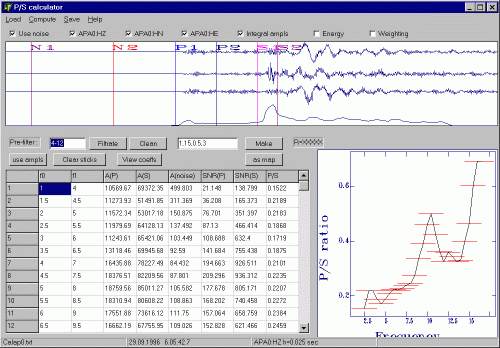

We analyzed recordings of several seismic events by ARCESS array. The choice of ARCESS was made because the array includes more than 20 vertical sensors and 4 3-component stations. It appeared that P/S computed by vertical sensors can differ very significantly (in times). Probably it is due to the medium inhomogeneity under ARCESS. P/S ratios calculated by 3-component stations appeared to be much more stable.
Ratios computed by average P and S amplitudes computed in time-compatible windows appeared to be the most stable. (see fig. below). We mean by 'time-compatible windows' those windows for which length of s-wave window is 1.7 times greater than p window. (1.7» vp/vs)
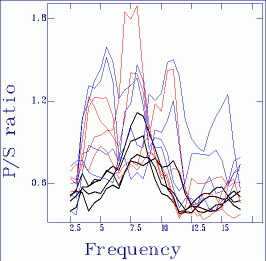
This approach was chosen for future computations. In a simplified form it was included into EL system for routine data processing.
Next we considered some specific cases to highlight influence of different factors:
1. P/S for events occurred in about the same place and recorded by one seismic station. In this case influences of propagation paths are the same for all events.
We selected 7 mining explosions in Khibiny Massif (both open-pit and underground ones) which were registered by ARCESS. We added a recording of induced earthquake (mine collapse) occured in Kirovsk mine immediately after underground explosion 16.04.1989.
We also added 3 mode events which we suspected to be rockbursts within the mining area. And one more was the event under Imandra lake 26.06.1996 (the propagation path to ARCESS is about the same). The list of the events is shown in table below (distances to ARCES are 380-400 km).
List of events.
| T0 | Mine | Remark |
| 28.07.1996 03.14:30 | Yukspor | Underground explosion 95 ton |
| 31.07.1996 11.09:25 | Koashva | Open-pit explosion 179 ton |
| 02.08.1996 11.19:35 | Central | Open-pit explosion 113 ton |
| 02.08.1996 11:23:52 | Central | Open-pit explosion |
| 16.08.1996 08.23:55 | Koashva | Open-pit explosion 94 ton |
| 29.09.1996 06.05:48 | Kirovsk | Underground explosion 350 ton |
| 12.10.1997 03.37:30 | Kirovsk | Underground explosion |
| 26.10.1995 05.31:06 | Rasvumchorr-Central | Rockburst |
| 17.11.1993 07.45:14 | Kirovsk | Rockburst |
| 12.12.1993 08.50:05 | Kirovsk-Yukspor | Rockburst |
| 26.06.1996 21.32:15 | Imandra lake | Earthquake |
| 16.04.1989 06.34:44 | Kirovsk | Mining collapse (induced earthquake) |
Results of P/S calculations are shown in fig. below.
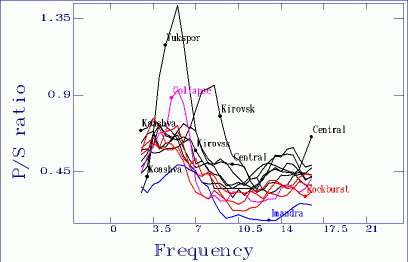
It is easy to see that the curves for explosions coincide well in low and high frequencies but scatter in 6-10 Hz range.
The curves for mining collapse and rockbursts lie below explosions curves. Imandra earthquake curve lie even lower.
2. P/S for events of the same kind, registered by the same station but occired in different places.
For this case we considered explosions in Kola Peninsula and North Kareliya mines registered by ARCESS. (Zapolyarny, Olenegorsk, Kostomuksha, Khibiny). The results are shown in fig. below.
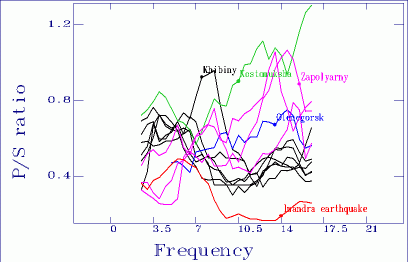
Significant difference between groups of curves is easily noticeable. Probable reasons of the difference may be influence of propagation paths or difference in exploding technique. We'll have to clear up the thing.
3. P/S for the same event but registered by different seismic stations (influences of propagation paths and radiation patterns).
A good example is Northern Norway earthquake 21.01.1996, 2.16:34 (69.156 N, 24.516 E, ML=3.9). By some estimations its depth is 15-30 km. Results of its recordings processing is shown in figure below.

The results can be divided onto 2 groups of very similar curves, each group containing both near and far stations: 1) AMD (1425 km), KEV (118 km) and 2) KBS (1144 km), LVZ (435 km) and AP0 (387 km).
The only explanation could be asymmetry of the source. The source and stations positions are shown in map below.
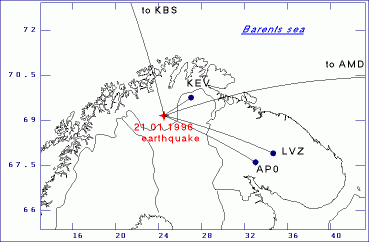
Indeed, azimuths from the sources to KEV and AMD stations are close, also LVZ and AP0 azimuths are close, KBS azimuth is almost opposite to AP0 one.
We drawn the conclusion that P/S ratio is not reliable criterion. Many earthquakes with asymmetrical sources can be identified as explosions. Nevertheless low P/S can be argument in favor that a seismic event is earthquake.
The conclusion can be well-illustrated by Spitsbergen earthquakes recordings. The figure below shows recordings of two earthquakes occurred in about the same place but their P/S ratios differ in several times!
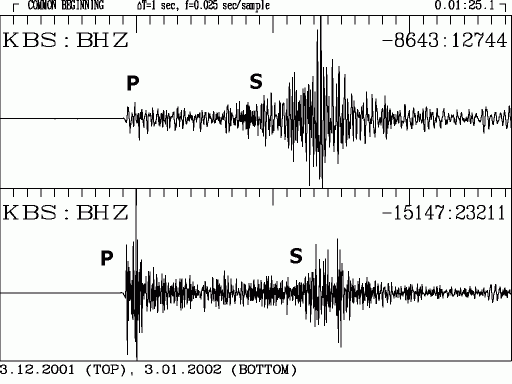

An interesting earthquake occurred near Bear Island (two figures below). Recordings of some other earthquakes to the west of Bear Island look very similar whereas events to the east have different shapes of recordings.
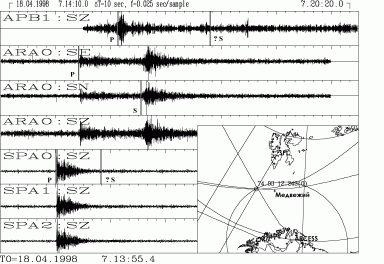
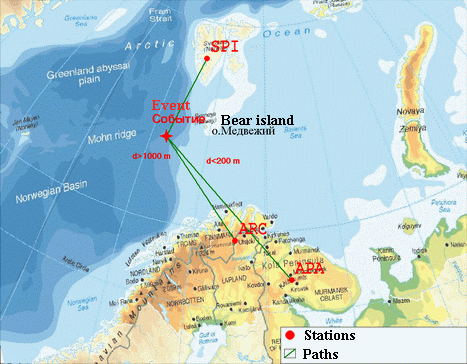
There are no S at SPI and APA recordings. Therefore the event should be classified as explosion. From the other hand, we can see relatively strong S on ARCESS. This is obviously due to propagation paths influence.
When we worked out a stable algorithm of P/S computing we included it into EL software for routine data processing. EL computes one S/P ratio which is averaged by a set of frequency bands.
When we made a data base of digital recordings of Apatity and Apatity array for all digital period (since 1992) we made a statistical analysis of S/P for different kinds of events.
It appeared that for most part of Kola Peninsula and Northern Norway earthquakes (excluding Lovozero Massif induced earthquakes or rockbursts) S/P is in average greater than for explosions, although a significant overlap does exist.
We think than S/P > 3 is a strong argument that an event is earthquake.
Figure below shows average S/P and their standard deviations for earthquakes and different kinds of explosions.
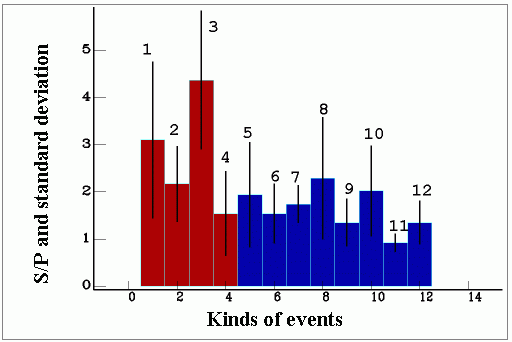
- earthquakes excluding Barents Sea and Lovozero Massif events;
- earthquakes (rockbursts) in Lovozero Massif;
- earthquakes near Lovozero Massif;
- events (probably earthquakes?) in Barents Sea;
- all explosions;
- Murmansk coast events;
- Zapolyarny explosions;
- Khibiny explosions;
- Olenegorsk explosions;
- Monchegorsk explosions;
- Kostomuksha explosions;
- Kovdor explosions;
S/P for earthquakes in average is greater than for explosions although a large overlap exists.
